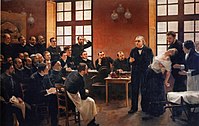
Photo from wikipedia
Dissociative disorders as described by ICD 10 include a range of disorders and combine what are conversion disorders (assumed under somatoform disorders in Diagnostic and Statistical Manual of Mental Disorders,… Click to show full abstract
Dissociative disorders as described by ICD 10 include a range of disorders and combine what are conversion disorders (assumed under somatoform disorders in Diagnostic and Statistical Manual of Mental Disorders, Fourth Edition) and the cluster of dissociative disorders. The mutual idea shared by these disorders is a partial or complete loss of usual integration between memories, cognizance of identity, and immediate sensations and voluntary control of body movements. Conversion occurs when there are clinical symptoms representing alteration of functioning of motor or sensory systems and which do not follow a pattern of a known neurological or medical disease. Dissociation is a mechanism that allows the mind to compartmentalize certain memories or thoughts from normal consciousness. These split-off mental contents are available and may return to consciousness either by an event or spontaneously. Broadly, dissociative disorders may be viewed as shown in Table 1. Table 1 Types of dissociative disorders
Journal Title: Indian Journal of Psychiatry
Year Published: 2020
Link to full text (if available)
Share on Social Media: Sign Up to like & get
recommendations!